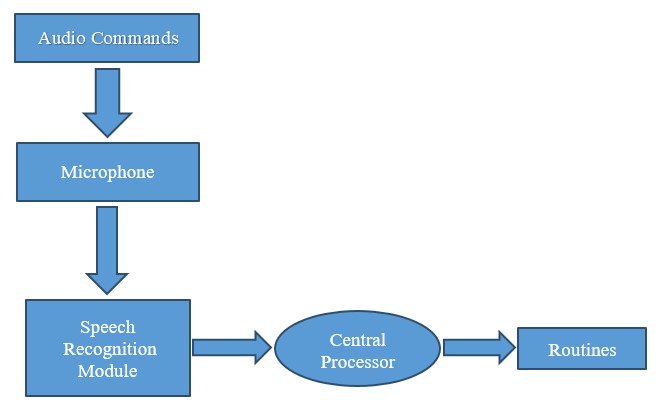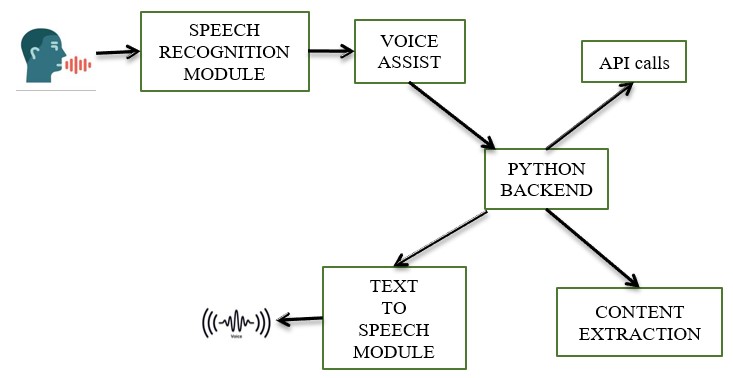A final year project on “Virtual Assistant Using Python” was submitted by Kavya Damarla (from Chalapathi Institute Of Engineering And Technology, Guntur, Andhra Pradesh) to extrudesign.com.

Abstract
In this modern era, day to day life became smarter and interlinked with technology. We already know some voice assistance like google, Siri. etc. Now in our voice assistance system, it can act as a basic medical prescriber, daily schedule reminder, note writer, calculator and a search tool. This project works on voice input and give output through voice and displays the text on the screen. The main agenda of our voice assistance makes people smart and give instant and computed results. The voice assistance takes the voice input through our microphone (Bluetooth and wired microphone) and it converts our voice into computer understandable language gives the required solutions and answers which are asked by the user. This assistance connects with the world wide web to provide results that the user has questioned. Natural Language Processing algorithm helps computer machines to engage in communication using natural human language in many forms.
I. Introduction
Today the development of artificial intelligence (AI) systems that can organize a natural human-machine interaction (through voice, communication, gestures, facial expressions, etc.) are gaining in popularity. One of the most studied and popular was the direction of interaction, based on the understanding of the machine by the machine of the natural human language. It is no longer a human who learns to communicate with a machine, but a machine learns to communicate with a human, exploring his actions, habits, behaviour and trying to become his personalized assistant.
Virtual assistants are software programs that help you ease your day to day tasks, such as showing weather reports, creating remainders, making shopping lists etc. They can take commands via text (online chatbots) or by voice. Voice-based intelligent assistants need an invoking word or wake word to activate the listener, followed by the command. We have so many virtual assistants, such as Apple’s Siri, Amazon’s Alexa and Microsoft’s Cortana.
This system is designed to be used efficiently on desktops. Personal assistants software improves user productivity by managing routine tasks of the user and by providing information from an online source to the user.
This project was started on the premise that there is a sufficient amount of openly available data and information on the web that can be utilized to build a virtual assistant that has access to making intelligent decisions for routine user activities.
Keywords: Virtual Assistant Using Python, AI, Digital assistance, Virtual Assistance, Python
II. Related Work
Each company developer of the intelligent assistant applies his own specific methods and approaches for development, which in turn affects the final product. One assistant can synthesize speech more qualitatively, another can more accurately and without additional explanations and corrections perform tasks, others can perform a narrower range of tasks, but most accurately and as the user wants. Obviously, there is no universal assistant who would perform all tasks equally well. The set of characteristics that an assistant has depends entirely on which area the developer has paid more attention to. Since all systems are based on machine learning methods and use for their creation huge amounts of data collected from various sources and then trained on them, an important role is played by the source of this data, be it search systems, various information sources or social networks. The amount of information from different sources determines the nature of the assistant, which can result as a result. Despite the different approaches to learning, different algorithms and techniques, the principle of building such systems remain approximately the same. Figure 1 shows the technologies that are used to create intelligent systems of interaction with a human by his natural language. The main technologies are voice activation, automatic speech recognition, Teach-To-Speech, voice biometrics, dialogue manager, natural language understanding and named entity recognition.
| Voice Technology | Brain Technology |
| Voice Activation | Voice Bio-metrics |
| Automatic Speech Recognition (ASR) | Dialog Management |
| (Teach-To-Speech (TTS) | Natural Language Understanding (NLU) Named Entity Recognition NER) |
III. Proposed Plan Of Work
The work started with analyzing the audio commands given by the user through the microphone. This can be anything like getting any information, operating a computer’s internal files, etc. This is an empirical qualitative study, based on reading above mentioned literature and testing their examples. Tests are made by programming according to books and online resources, with the explicit goal to find best practices and a more advanced understanding of Voice Assistant.

Fig.2 shows the workflow of the basic process of the voice assistant. Speech recognition is used to convert the speech input to text. This text is then fed to the central processor which determines the nature of the command and calls the relevant script for execution.
But, the complexities don’t stop there. Even with hundreds of hours of input, other factors can play a huge role in whether or not the software can understand you. Background noise can easily throw a speech recognition device off track. This is because it does not inherently have the ability to distinguish the ambient sounds it “hears” of a dog barking or a helicopter flying overhead, from your voice. Engineers have to program that ability into the device; they conduct data collection of these ambient sounds and “tell” the device to filter them out. Another factor is the way humans naturally shift the pitch of their voice to accommodate for noisy environments; speech recognition systems can be sensitive to these pitch changes.
IV. Methodology of Virtual Assistant Using Python

Speech Recognition module
The system uses Google’s online speech recognition system for converting speech input to text. The speech input Users can obtain texts from the special corpora organized on the computer network server at the information centre from the microphone is temporarily stored in the system which is then sent to Google cloud for speech recognition. The equivalent text is then received and fed to the central processor.
Python Backend:
The python backend gets the output from the speech recognition module and then identifies whether the command or the speech output is an API Call and Context Extraction. The output is then sent back to the python backend to give the required output to the user.
API calls
API stands for Application Programming Interface. An API is a software intermediary that allows two applications to talk to each other. In other words, an API is a messenger that delivers your request to the provider that you’re requesting it from and then delivers the response back to you.
Content Extraction
Context extraction (CE) is the task of automatically extracting structured information from unstructured and/or semi-structured machine-readable documents. In most cases, this activity concerns processing human language texts using natural language processing (NLP). Recent activities in multimedia document processing like automatic annotation and content extraction out of images/audio/video could be seen as context extraction TEST RESULTS.
Text-to-speech module
Text-to-Speech (TTS) refers to the ability of computers to read text aloud. A TTS Engine converts written text to a phonemic representation, then converts the phonemic representation to waveforms that can be output as sound. TTS engines with different languages, dialects and specialized vocabularies are available through third-party publishers.
V. Conclusion
In this paper “Virtual Assistant Using Python” we discussed the design and implementation of Digital Assistance. The project is built using open source software modules with PyCharm community backing which can accommodate any updates shortly. The modular nature of this project makes it more flexible and easy to add additional features without disturbing current system functionalities.
It not only works on human commands but also give responses to the user based on the query being asked or the words spoken by the user such as opening tasks and operations. It is greeting the user the way the user feels more comfortable and feels free to interact with the voice assistant. The application should also eliminate any kind of unnecessary manual work required in the user life of performing every task. The entire system works on the verbal input rather than the next one.
References
- [1] R. Belvin, R. Burns, and C. Hein, “Development of the HRL route navigation dialogue system,” in Proceedings of ACL-HLT, 2001
- [2] V. Zue, S. Seneff, J. R. Glass, J. Polifroni, C. Pao, T.J.Hazen,and L.Hetherington, “JUPITER: A Telephone Based Conversational Interface for Weather Information,” IEEE Transactions on Speech and Audio Processing, vol. 8, no. 1, pp. 85–96, 2000.
- [3] M. Kolss, D. Bernreuther, M. Paulik, S. St¨ucker, S. Vogel, and A. Waibel, “Open Domain Speech Recognition & Translation: Lectures and Speeches,” in Proceedings of ICASSP, 2006.
- [4] D. R. S. Caon, T. Simonnet, P. Sendorek, J. Boudy, and G. Chollet, “vAssist: The Virtual Interactive Assistant for Daily Homer-Care,” in Proceedings of pHealth, 2011.
- [5] Crevier, D. (1993). AI: The Tumultuous Search for Artificial Intelligence. New York, NY: Basic Books, ISBN 0-465-02997-3.
- [6] Sadun, E., &Sande, S. (2014). Talking to Siri: Mastering the Language of Apple’s Intelligent Assistant.
Credit: This Project “Virtual Assistant Using Python” was completed by Damarla Kavya, Daddanala Suvarna, Javisetti Srinivas and Chintha Venkata Ramaiah from the Department Of Electronics And Communication Engineering, Chalapathi Institute Of Engineering And Technology, Guntur, Andhra Pradesh.

Leave a Reply